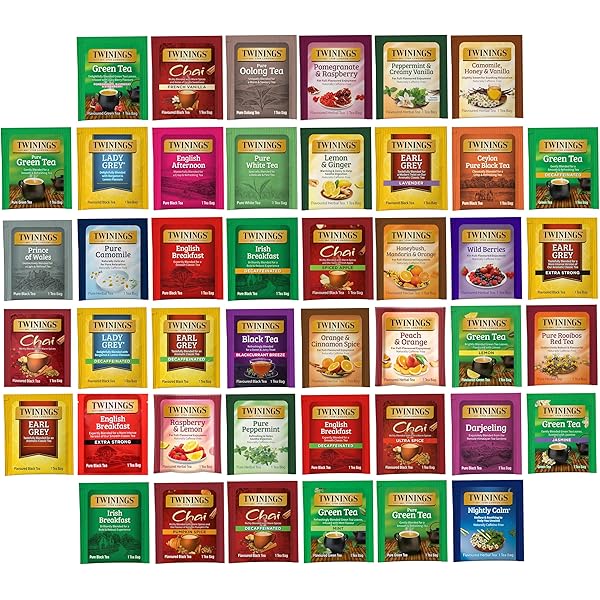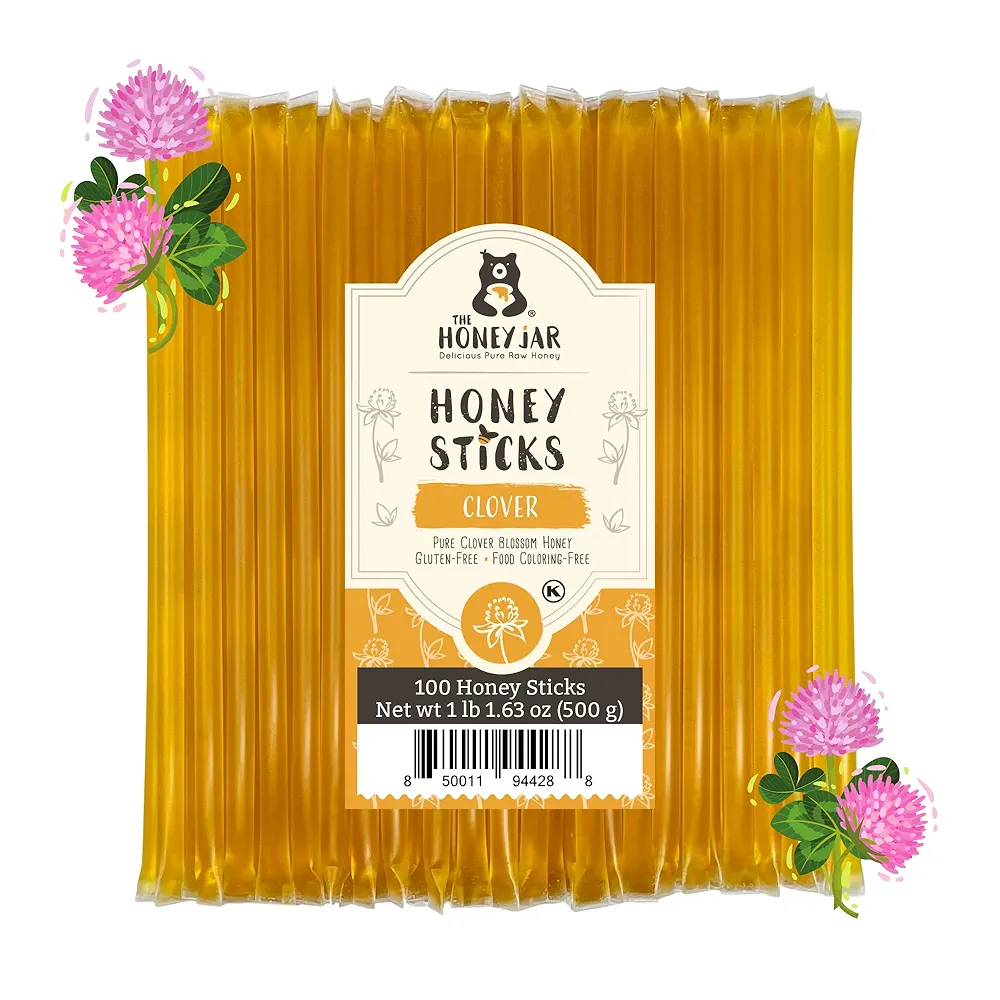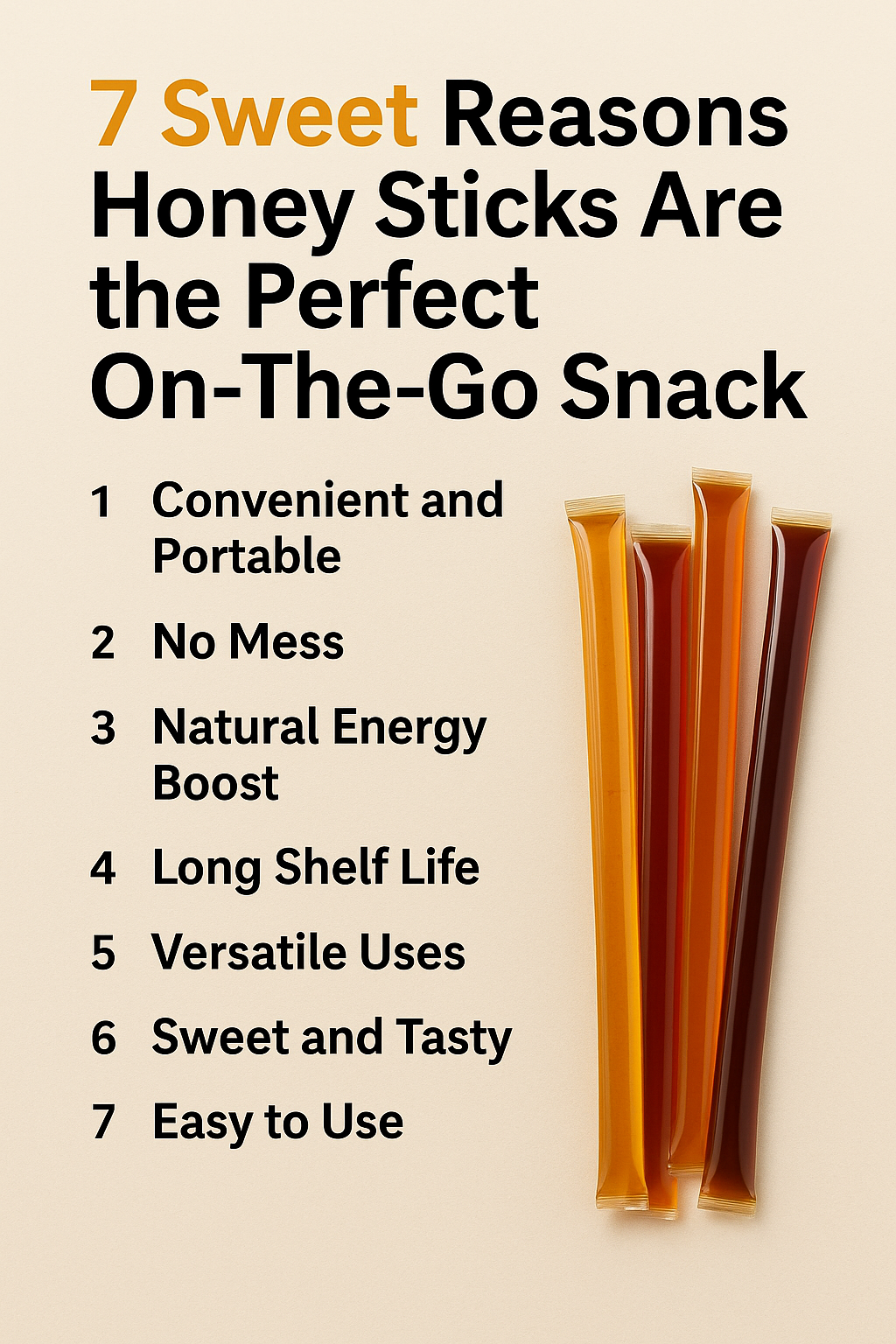Introduction
Simple, sweet, and endlessly versatile, honey sticks have gained massive popularity in recent years for their convenience, health appeal, and versatility. These tiny tubes filled with pure honey aren’t just for tea anymore. From outdoor adventures to school lunches, health boosts to skincare DIYs, honey sticks serve countless purposes. This article explores everything you need to know about them—from their origins to their surprising uses, and why they deserve a place in your pantry or backpack.
What are honey sticks
Honey sticks, also known as honey straws, are slender plastic or biodegradable tubes filled with pure honey. Typically around six inches long, these sealed sticks contain roughly 5 to 7 grams of honey each. They can be made with raw honey, flavored varieties, or even infused with herbs or spices for enhanced benefits. Designed to be portable and mess‑free, honey sticks are easy to open—just bite and squeeze.
A brief history of honey sticks
Though honey has been harvested for thousands of years, the innovation of honey sticks is relatively new, dating back to the 1970s. The concept was born out of a desire to make honey more accessible and travel-friendly. Over time, as consumer demand for natural snacks and sugar alternatives grew, honey sticks began to gain mainstream attention in markets, cafes, health food stores, and even gas stations.
Types of honey used in honey sticks
The most common types of honey found in sticks include clover, wildflower, orange blossom, and buckwheat. Each type has a unique color, taste, and nutrient profile. Raw, unfiltered honey is especially popular in honey sticks because of its retained enzymes and antioxidants. Some brands also use creamed honey for a thicker, more textured experience.
How honey sticks are made
The process of making honey sticks involves three simple steps. First, pure honey is filtered to remove wax and impurities. Next, it is heated slightly to reduce viscosity, making it easier to dispense. Finally, it is pumped into narrow food-grade tubes which are heat-sealed at both ends. Flavoring, when used, is typically added during the filtering stage or mixed into the batch before sealing.
Popular flavors of honey sticks
Beyond traditional honey, there are endless flavor possibilities. Common flavors include cinnamon, lemon, ginger, lavender, vanilla, blueberry, and peppermint. Some brands even offer bold options like jalapeño honey or matcha-infused honey. The infusion of herbs or essential oils creates an enhanced sensory experience and often serves functional purposes like calming or energizing effects.
Nutritional profile of honey sticks
Each honey stick contains around 20 calories, with all of that coming from natural sugars like fructose and glucose. They contain trace amounts of vitamins and minerals, including B vitamins, calcium, and iron. Raw honey sticks also provide antioxidants, which support immune health and combat inflammation. While not a low-calorie food, honey is a natural alternative to processed sugars.
Health benefits of honey sticks
Honey sticks offer more than just sweetness. They provide energy quickly, making them ideal for athletes, hikers, or anyone in need of a fast pick‑me‑up. Raw honey also contains antibacterial and antifungal properties. Consuming a stick before bed may help soothe a sore throat or quiet nighttime coughing. In moderation, honey can support digestion and even improve seasonal allergies when made from local sources.
Also read:herzhafte hackfleisch kartoffelbrötchen ein wärmendes komfortnahrung
Are honey sticks good for kids
Yes, honey sticks are often considered a kid-friendly treat, especially when unflavored or lightly infused. They are a healthier alternative to candy and contain no artificial ingredients. However, they should not be given to children under the age of one due to the risk of botulism from raw honey. For older children, they make excellent additions to lunchboxes, party favors, or healthy dessert options.

Honey sticks and dental health
Although honey is a natural sugar, it still feeds oral bacteria, potentially contributing to cavities if consumed excessively or without proper dental hygiene. However, honey’s antibacterial qualities can counter some of the harmful effects if used moderately. Dentists recommend rinsing or brushing after eating honey sticks, just as you would with any other sweet treat.
Are honey sticks keto or diabetic-friendly
For those following a keto lifestyle, honey sticks are not suitable due to their natural sugar content. Diabetics should approach with caution. While honey has a lower glycemic index than table sugar, it still raises blood glucose. Some brands offer sugar-free or monk fruit sweetened alternatives, but these are rare in the honey stick format.
Best ways to use honey sticks
Honey sticks are versatile and can be enjoyed in several ways. Tear the tip and suck it directly as a sweet snack. Stir them into tea or coffee for a natural sweetener. Use them on toast, yogurt, oatmeal, or pancakes. Some people even drizzle them on fruit or into smoothies for an energy boost. They also work well in baking or cooking when you want a touch of sweetness without measuring sticky jars.
Honey sticks as travel companions
When traveling or hiking, honey sticks are a perfect energy booster. They are light, non-perishable, and mess-free. Athletes also appreciate them for pre- or mid-workout glycogen replenishment. Their quick-access packaging and long shelf-life make them suitable for camping trips, road travel, and even international flights where liquids are limited.
Using honey sticks in skincare
Honey sticks can serve double duty as beauty products. The natural enzymes and moisturizing properties of honey make it a powerful skincare ally. Many use honey sticks in face masks, lip scrubs, or even as quick on-the-go moisturizers. Combined with natural oils or oats, a single stick can become the star ingredient of a DIY spa treatment.
Do honey sticks expire
Pure honey, even in stick form, does not spoil under normal storage conditions. Its high sugar content and low moisture make it inhospitable to bacteria and mold. However, most commercial honey sticks carry a “best by” date of 2 to 3 years, after which the color may darken and flavor may degrade. To maximize shelf life, store them in a cool, dry place away from sunlight.
Packaging and sustainability concerns
Most honey sticks are packaged in plastic, which has raised concerns among eco-conscious consumers. However, several brands have begun transitioning to biodegradable or compostable materials. Glass or paper-based alternatives exist, although less common due to cost. Consumers are encouraged to recycle or dispose responsibly, especially when using them outdoors.
Where to buy honey sticks
Honey sticks are widely available in health food stores, farmer’s markets, online retailers, and even some supermarkets. They often appear in natural or organic food aisles. Local beekeepers also sell homemade versions that use region-specific honey, offering freshness and allergen support. Online platforms offer the greatest flavor variety and bulk purchase options.
Making your own honey sticks at home
DIY honey sticks can be created using food-grade tubing, a funnel, and a heat sealer. After choosing your honey (and optionally adding natural flavors), pour it into tubes and seal the ends using a heat gun or impulse sealer. Homemade sticks can be customized for flavor, size, and labeling, making them great for gifting or special events.
Honey sticks as party favors or gifts
Due to their elegant look and universal appeal, honey sticks are becoming popular wedding favors, baby shower giveaways, and corporate gifts. Paired with custom labels, tea bags, or mini jars of honey, they offer a sweet and memorable touch to any occasion.
Conclusion
Honey sticks are far more than a novelty. They combine nature’s sweetness with unmatched portability and countless practical uses. Whether you’re an athlete in need of fast energy, a parent looking for healthier kid snacks, or someone seeking a natural skincare ingredient, honey sticks deliver. Their rising popularity stems from their convenience, natural origin, and ability to fit into so many lifestyles. From their flavors to their health perks, they embody the idea that great things can indeed come in small packages.
FAQs
Are honey sticks made from raw honey
Many honey sticks use raw, unfiltered honey to retain antioxidants, enzymes, and health benefits. However, some brands may use pasteurized honey for shelf stability. Always check the label for clarification.
Can you carry honey sticks on a plane
Yes, honey sticks are considered solid due to their packaging and are allowed in both checked and carry-on luggage according to TSA guidelines. They’re a great travel sweetener option.
Do honey sticks help with allergies
Locally produced honey sticks may help build resistance to regional pollen allergies due to trace pollen content. However, scientific support is mixed, and benefits may vary by individual.
How many honey sticks can you eat per day
Moderation is key. One to three sticks per day is generally safe for healthy adults. Overconsumption can lead to excess sugar intake, even though honey is natural.
Are flavored honey sticks natural
Most flavored honey sticks use natural extracts, essential oils, or herbal infusions. However, some may contain artificial flavors or sweeteners. Look for ingredient transparency on packaging.
Can honey sticks be used for pets
In small amounts, honey is safe for most pets, particularly dogs. It can help with minor wounds or digestive upset. However, it should be used sparingly, and never given to animals with diabetes or weight issues.







